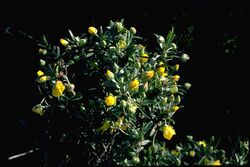Biology:Hibbertia potentilliflora
| Hibbertia potentilliflora | |
|---|---|

| |
| Near Coorow | |
| Scientific classification | |
| Kingdom: | Plantae |
| Clade: | Tracheophytes |
| Clade: | Angiosperms |
| Clade: | Eudicots |
| Order: | Dilleniales |
| Family: | Dilleniaceae |
| Genus: | Hibbertia |
| Species: | H. potentilliflora
|
| Binomial name | |
| Hibbertia potentilliflora Benth.[1]
| |
Hibbertia potentilliflora is a species of flowering plant in the family Dilleniaceae and is endemic to the west of Western Australia. It is an erect or low-lying shrub that typically grows to a height of 15–60 cm (5.9–23.6 in) and has yellow flowers.[2] It was first formally described in 1863 by George Bentham in Flora Australiensis from specimens collected from the Swan River Colony by James Drummond and from near the Murchison River by Augustus Oldfield.[3][4] The specific epithet (potentilliflora) means "Potentilla-flowered".[5]
Hibbertia potentilliflora grows in a range of soils on rocky hillsides and coastal sandstone in the Avon Wheatbelt and Geraldton Sandplains biogeographic regions of western Western Australia. It is classified as "not threatened" by the Western Australian Government Department of Parks and Wildlife.[2]
See also
References
- ↑ "Hibbertia potentilliflora". Australian Plant Census. https://biodiversity.org.au/nsl/services/apc-format/display/90531.
- ↑ 2.0 2.1 "Hibbertia potentilliflora". FloraBase. Western Australian Government Department of Parks and Wildlife. https://florabase.dpaw.wa.gov.au/browse/profile/5158.
- ↑ "Hibbertia potentilliflora". APNI. http://id.biodiversity.org.au/instance/apni/512169.
- ↑ Bentham, George; von Mueller, Ferdinand (1863). Flora Australiensis. 1. London: Lovell Reeve & Co. p. 40. https://www.biodiversitylibrary.org/item/3669#page/98/mode/1up. Retrieved 7 July 2021.
- ↑ Sharr, Francis Aubi; George, Alex (2019). Western Australian Plant Names and Their Meanings (3rd ed.). Kardinya, WA: Four Gables Press. p. 282. ISBN 9780958034180.
Wikidata ☰ Q17395391 entry
 |

